What is your favorite statue in Rome? Find out with this handpicked selection of famous sculptures in Rome. Statues in Rome piazzas, streets and museums and the info you need to plan a visit.
Alberto Sordi, a famous Italian actor from Rome, famously said (quote): ‘Rome is not like any other city. It’s a big museum, a living room that shall be crossed on one’s toes’.
Indeed, Rome has so many statues, sculptures and treasures, strolling along its streets and piazzas often feels like walking into the chambers of a curated museum.
Some of the most famous statues in Rome are in museums of the capital however, many are not: they are scattered around the city, sometimes in churches and sometimes in public spaces, and they can be enjoyed by artist lovers and passers by.
There are too many sculptures in Rome to list them all: this is a curated selection of the best statues of Rome and tips to go see them.
Famous statues in Rome chart
| Name of sculpture | Author | Location | Free |
| Pieta’ | Michelangelo | St Peters’ Basilica | Y |
| Moses | Michelangelo | San Pietro in Vincoli church | Y |
| Exstasis of St Therese | Bernini | Santa Maria della Vittoria Church | Y |
| Small elephant sculpture | Bernini | Piazza della Minerva | Y |
| Fountain of the 4 rivers | Bernini | Piazza Navona | Y |
| Equestrian statue of Marcus Aurelius | Roman statue | Piazza del Campidoglio | Y |
| Statues of the Dioscuri | Roman statues | Piazza del Campidoglio | Y |
| Statue of Pasquino | Hellenistic statue | Piazza Pasquino | Y |
| Statue of Giordano Bruno | Ettor Ferrari (1885) | Piazza Campo de’ Fiori | Y |
| Statues on St Angel’s Bridge | Bernini and disciples | Ponte Sant’Angelo | Y |
| Statue of Julius Caesar | Roman Statue | Via dei Fori Imperiali | Y |
| Sculptures of Trevi Fountains | Nicola Salvi (1732) | Piazza Fontana di Trevi | Y |
| Sculptures of Trajan’s Column | Roman Sculpture | Piazza Venezia | Y |
| Sculptures of Ara Pacis | Roman Sculpture | Piazza Augusto Imperatore | N |
| Statues of Foro Italico | Several authors, 1928-1932 | Stadio dei Marmi | Y |
| Angel of Grief | William Wetmore Story (1894) | Non catholic cemetery of Rome | Y |
| Apollo and Daphne | Bernini | Borghese Gallery | N |
| Taking of Proserpina | Bernini | Borghese Gallery | N |
| Mouth of Truth | Roman sculpture | Santa Maria in Cosmedin | N |
| Boy with goose | Roman statue | Capitoline Museums | N |
| Dying Gaul | Roman statue | Capitoline Museums | N |
| Laocoon | Roman statue | Vatican Museums | N |
| St Peter’s Statue | Arnolfo di Cambio | St Peter’s Basilica | Y |
| Capitoline Wolf | Unknonwn | Capitoline Museums | N |
Unmissable statues in Rome
Michelangelo’s Pieta’ – the most famous statue in Rome
One of the most famous if not the most famous statue in Rome is La Pieta’ by Michelangelo, a world famous sculpture hosted inside St Peter’s Basilica.
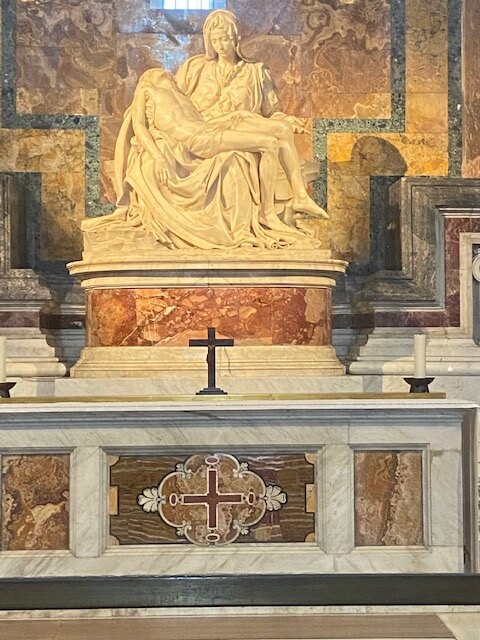
The statue represent Mary holding the body of dying Jesus and it is carved in white Carrara marble, a piece that Michelangelo has declared the ‘most perfect’ he had ever seen.
The statue sits inside St Peter’s basilica and you find it immediately to your right as you enter from the main door.
The sculpture is now protected by a glass but it is easy to see and an absolute marvel. For beauty, mastery of its creation and evocative power, this is a statue in Rome you should not miss.
Where it is: inside St Peter Basilica Access: free Find all the info you need for seeing Michelangelo’s Pieta here.
Michelangelo’s Moses – stunning burial sculpture in Rome’s St Pietro in Vincoli
Another famous statues in Rome by Michelangelo is the Moses inside the church of San Pietro in Vincoli (St Peter in chains).

The statue is part of the large burial monument to Pope Julius II and was carved by Michelangelo over the course of many years, from 1513-1542
It now occupies the top right chapel inside the church, right beside the main altar, and it s sight to behold: the statue is carved with such detailing and attention that Moses seems to be about to leave his seat and leap forward, a dynamic Michelangelo achieved with the precise definition of the legs and veins of this Marble giant.
The statues is masterpiece and has attracted the attention of many for its beauty but also for a peculiar detail: on top of Moses’ head Michelangelo posed two little horns and they are so surprising and unique that this sculpture is often referred to as Michelangelo’s Moses with horns!
You can read why Michelangelo represented his Moses with horns and how to see this beautiful statue in this guide to visiting the church of San Pietro in Vicoli.
Estasi di Santa Teresa – Extasis of St Therese by Bernini
The extasis of St Therese is one of the most famous sculptures in Rome by Gian Lorenzo Bernini one of Rome’s most talented and prolific artists.
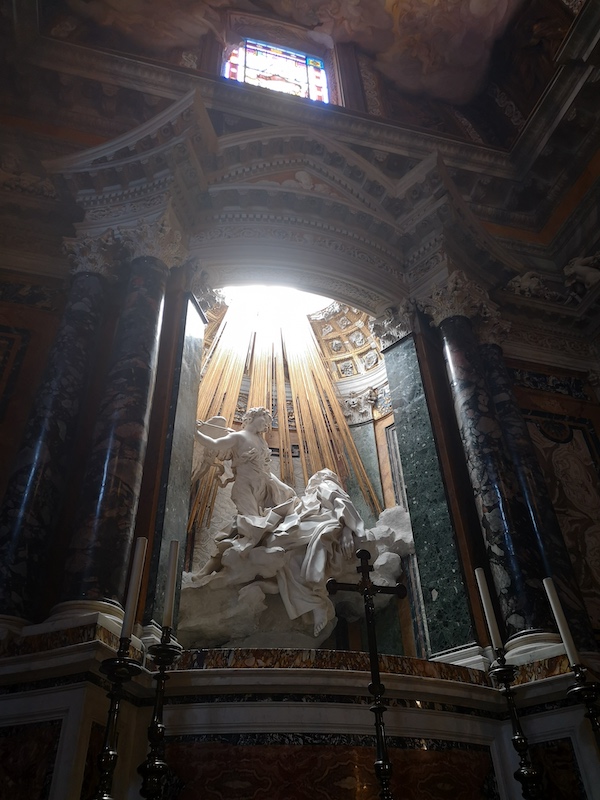
The statue is in a side chapel inside the church of Santa Maria della Vittoria and represents St Therese in a moment of mystical rapture, in the presence of an angel and surrounded by rays of light.
The statue has wonderful detailing and has a strong sensual power never ceases to impress viewers
Address: Santa Maria della Vittoria, Largo di Santa Susanna, Rome. You can learn how to visit this statue and other works of Bernini in Rome here
The Equestrian Statue of Marcus Aurelius – best preserved bronze statue in Rome
The equestrian statue of Marcus Aurelius stands in Piazza del Campidoglio, the beautiful Renaissance square designed by Michelangelo, at the top of the Capitoline Hill.
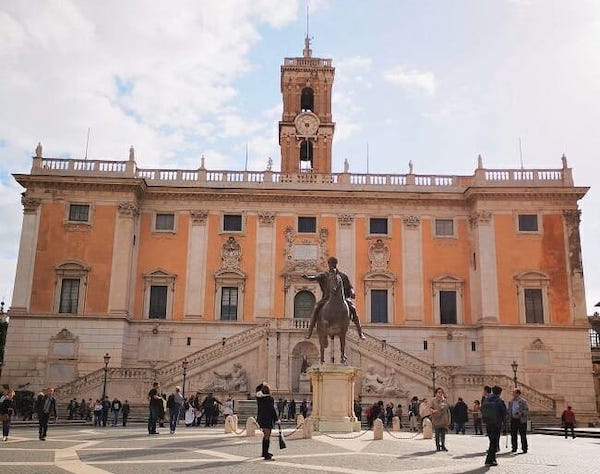
The statue is one of the most important sculptures in Rome as it is the only fully preserved Roman bronze equestrian statue we have and it has such a significance for Italy that is it represented on the first page of Italian passports and on the 50c Italian Euro coin!
The statue we see now in Piazza del Campidoglio is a replica of the original one, now in the Capitoline Museums however, it is a powerful for size and location as the real thing.
On the same square, you find more beautiful statues worth seeing, namely:
The statues of the River Tiber and Nile, represented as two bearded men at the two side a statue of Minerva: the ensemble forms the renaissance Fountain of the Rome Goddess.
The statues of the Dioscuri, Castor and Pollux, sons of the Sun, represented as two young main, standing at the top of the Cordonata, the monumental staircase leading into the piazza.
The statues of the Roman she-wolf, or rather, a copy of the original (see below), perched on top of a column at the back of the entrance to Piazza del Campidoglio.
Address: Piazza del Campidoglio. Learn how to visit the Capitoline Hill and all its treasures here
The statue of Pasquino and the talking statues of Rome
The statue of Pasquino is located in Piazza Pasquino, in Rome city center, and it is the most famous of a group of 6 statues scattered around the city known as the ‘talking statues of Rome’,
The talking statues of Rome are called this was as they were used in papal times to show discontent against the government of Rome.
At a time when expressing dissent wasn’t allowed, at night time people would go to these states and leave pamphlets and complaints, so that the states were ‘talking’ for them.
The 6 statues are called Pasquino, Marforio, Madama Lucrezia, Abate Luigi (abbot Luigi), Il Babuino (the Baboon), and Il Facchino (the Porter), these last two not just statues but drinking fountains.
Fontana dei 4 fiumi – fountain of the four rivers, the most famous sculpture in Rome Piazza Navona
The fountain of the 4 rivers is one of the most famous sculptures in Rome and one of the best known. The fountains adorns the center of Piazza Navona, Rome’s most famous square, and it was designed and created by Bernini.
The statue represents the 4 great rivers of the world of that time, each of them represented as a man, with details symbolising the river they represent.
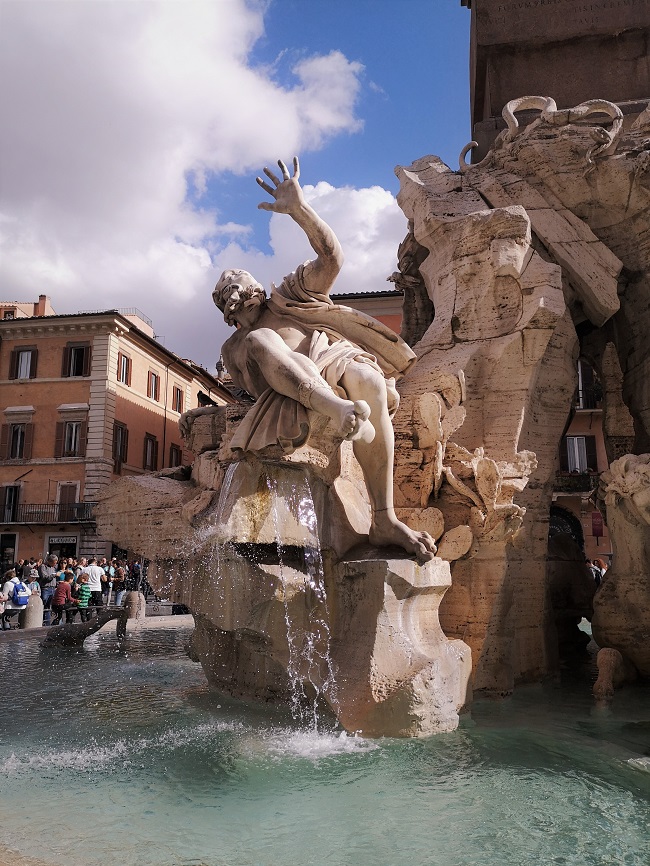
The Nile – the statue of the river Nile is represented as a male figure with a veiled head and his head turned away from the observer, to symbolise that the source of Nile where unknown
The Rio de la Plata – this river is represented as a man with small coins, representing the silver that gives the river its name.
Fun fact: the statue is represented in a moment of terror, with an arm raised as if to protect himself from danger. Taking inspiration from the well known rivalry between Bernini author of the fountain and Borromini, author of the church in front, the gossip went around that the statue was covering their eye in fear the church would fall on him! This is, however, just legend since the church was built after the statue. More likely, the terror wants to symbolize the fear of the rich of losing their wealth, a danger represented on the fountain by the inclusion of a small snake.
The Danube – represented by powerful horses and flowers to represent the large and fertile Danubian plains
The Gange – represented with an oar, to highlight the ease of navigation.
The fountains is surmounted by an ancient obelisk, one of the 13 ancient obelisks in Rome.
Address: Piazza Navona. You can learn more about Piazza Navona and its fountains here.
Bernini’s statue of the small elephant: the most unexpected statue in Rome
One of the prettiest and most peculiar sculptures in Rome is that of the little elephant by Bernini. The statues is in the center of piazza della Minerva and represents a small elephant with an obelisk on its back.
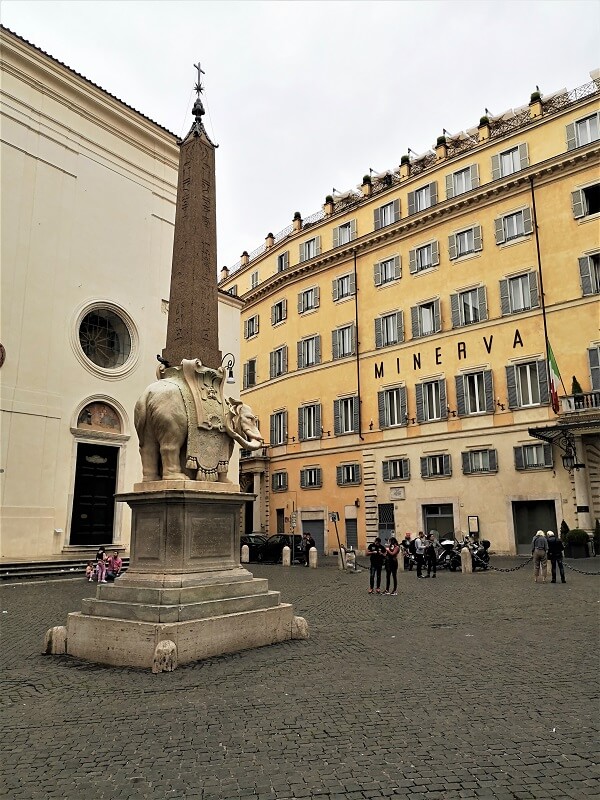
The statue was made by Bernini in 1667 and it caused huge controversy.
Bernini was criticized for making a statue that was, according to its detractors, ugly and unstable, so Bernini took his revenge adding a detail to show his despise for his detractors!
Address: Piazza della Minerva. Read the full story and what detail he hid in our guide to Piazza della Minerva here
The statue of Giordano Bruno – maybe the most somber statue of Rome
At the center of Campo de’ Fiori stands the dark statue of Giordano Bruno, represented like a hooded figure looking down.
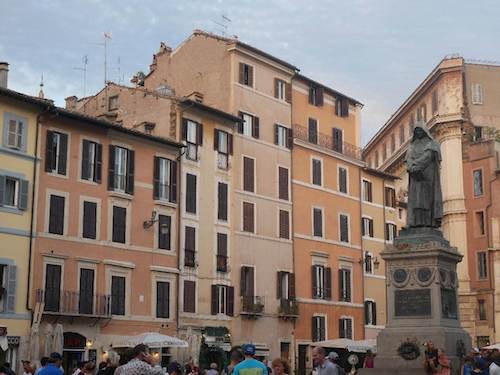
The statue is here to commemorate the death of Giordano Bruno at the stake, happened in this very location in year 1600 and was made erected in the piazza in 1885.
The statue is poerful and often considered a memento of what happens with repression on scientific though however, the stmosphere around the statue is all but sombre!
Piazza Campo de’ Fiori is one of the liveliest squares in Rome and has dining tables all around it! Still, the sculpure is one of the most important and significant statue in Rome and one worth seeing.
Address: Piazza Campo de’ Fiori. You can learn how to visit Campo de’ Fiori here.
The statue of Julius Caesar
You would expect a statue of Julius Caesar to be present in Rome and indeed there is!
The statue is on Via dei Fori imperiali, the large momumental road that flanks the roman forum and it is one of the many statues of emperors on that strectnof road.
Unexpectedly for many, the statue doesn’t get a lot of attention and often it is the backdrop to buskers and street musicians! With so much competition for attention in Rome, not even Caesar stands out!
Fun fact: many people miss this statue and take pictures under a different statue, that of Emperor Nerva, by mistake!
Address: Via dei Fori Imperiali
The Mouth of Truth – one of the most peculiar statues in Rome, with Hollywood fame!
The Mouth of truth is a very peculiar sculpture in Rome, representing a large round face of a monster with a hole as its mouth.
The statue is in the portico of the church of Santa Maria in Cosmedin and has huge notoriety due to a couple of fact: the legend that says the monster will bite off your hand, if you tell a lie while having your hand in its mouth and its role in many movies set in Rome, especially the very famous ‘A Roman Holiday’.
The statue is unique and fun and while it may not be worth lining up to place your hand in it, it is sure worth seeing even just seeing it from outside its fence.
Address: piazza Santa Maria in Cosmedin
The statues on Ponte Sant’Angelo
Several beautiful statues are on Ponte Sant’Angelo, the bridge leading to the entrance of St Angelo’s Castle, along the river Tiber.
The statues were part of a large urban design by Bernini who also designed piazza San Pietro nearby and represent 10 angels, two of them by Bernini himself and 8 by his disciples.
Good to know: the two angels by Bernini are now in the church of Sant’Andrea delle Fratte and those on the bridge are replicas (albeit so good, most people wouldn’t even realise it!)
The statues of Rome Trevi Fountain
The Trevi Fountain is a large monumental fountain in the city and one of the most famous monuments in Rome.
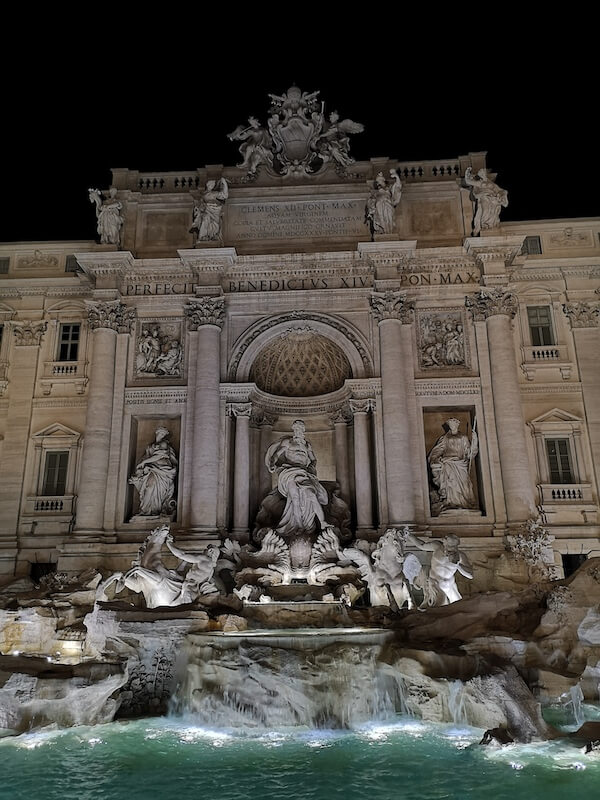
The fountain is huge and full of statues and sculptures: among the most notable there is the chariot of Oceanus pulled by horses, the personifications of abundance and health the Papal stem of Clemens II.
Address: Piazza di Trevi. You can read about the Trevi Fountain and how to visit here.
The statue of St Peter in St Peter basilica
Inside the basilica of St Peter there is an important statue representing St Peter himself and dating from the Middle Ages.
The statue is made of bronze and it attributed to artist Arnolfo di Cambio, who would have created it in the XIII century.
The statue has a peculiarity: for centuries, pilgrims would walk by it and kiss one of his feet, for benediction. This happened so much, the foot of St Peter is now consumed!
The statues of Foro Italico
The statues in Rome Foro Italico are very different from others in this list as they are neither ancient nor baroque but modern, made in the 1930.
The statues are part of the fascist project that created a ‘modern Roman forum’, a place for sports that wanted to symbolise the importance that fascism put on physical strength and virility.
The statues are huge and represent young athletes, in guises similar to those represented in classical sculptures.
Foro Italico is immediately outside of the city centre and you need to specifically head here to see the statues: if you have more than one day in Rome and are interested in something a little different, this is a good place to explore!
The Angel of Grief
Another beautiful modern statue in Rome I recommend you go see is the angel of grief, a burial statue in the non-catholic cemetery of Rome.
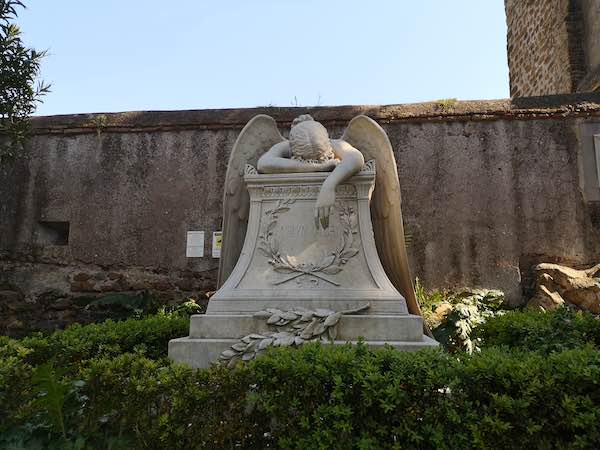
The statue represents and crying angel and was made in 1894 by William Wtmot Story, at the death of his wife. The statue and the cemetery are free to visit however, a donation is welcome.
You can read more about Rome’s non-catholic cemetery and how to visit here.
Statues in Rome museums you cannot miss
So far, I have listed statues that you can encounter during a stroll around Rome however, some of the most important sculptures in Rome are, unsurprisingly, in museums.
Some worth seeing are:
Boy with goose (Bambino che strozza un’oca)
Boy with goose is a famous statue in Rome representing a child chocking a goose.
The statues is made of marble and is a Roman copy of an Hellenistic statue form the III century BC by Boethos of Calcedonia.
Dying Gaul
This is one of the most famous statues in Rome’s Capitoline Museums and is a roman replica of a Hellenistic statue representing a dying Gaul (or The Dying Galatian as it is also known).
You can get tickets for the Capitoline Museums here (direct museum link)
Bernini’s statue of Apollo and Daphne
Wonderful marble statue by Bernini now in the Borghese Gallery, capturing the movement when Daphne, escaping Apollo, starts turning into a laurel.
Noticeable in this statue, like in others by turning is the portion of the body of the main character that forces the observed to move around the statue to capture all it sides, deepening the relationship between observer and observed.
The taking of Proserpina, Bernini – one of the most famous statues in Rome
Another baroque masterpiece by Bernini in the Borghese Gallery is the abduction of Proserpina, representing the moment when Proserpina is taken into by Pluto, God of the Underworld.
The statue is one of the several by Bernini carved with reference to Romand Gods and epic tales and uses the same technique as the one mentioned above: an evoked movement in the positioning of the body of the statue that forces the observed to ‘move’ with her.
Paolina Bonaparte, Antonio Canova
Lovers of neoclassical sculptures and Antonio Canova should not miss he statue of Palina Buonaparte as Venus Victoria in the Borghese gallery.
Commissioned by Paolina’s husband Camillo Borghese, the statue represent Paolina with the guise of goddess Venus, leisurely lying on a dormeuse while holding an apple, a hint to Venus’ victory in the beauty contest that ultimately sparked the Trojan war.
Bernini’s David
Again in the Borghese Gallery you will dfind the famous Davide by Bernini one of the most famous renaissance statues of Rome.
The sculpture dates from 1623-24 and shows a young David getting ready to throw the deadly blow.
The statue evokes incredible physical power and dynamism and uses a technique already seen in other statues by Bernini: a tortion in the body of the main character that forces the observer to move with it and take it in from more than one location.
The statue of Laocoon at the Vatican Museums
One of my favotire statues in Rome is the beautiful statue of the Laocoon, in the Vatican Museum.
The Statue dates from Hellenistic times and represents Laocoon and his sons taken by the spires of a sea serpent, as described in Virgil’s Aeneid.
You can get tickets for the Vatican Museums here (official site).
The statue of Rome she wolf
There are many animal statues in Rome however, no one has bigger significance than the statue of the she-wolf, the animal symbol of Rome.
The legends tells us that a she-wolf rescued the twins Romulus and Remus and nursed them to strength, effectively ensuring the survival of the founder of Rome: Romulus.
Her motherly role has been immortalized several times in statues, carvings and images all over the city and the best place to see her are the Capitoline Museum, where you can see her carved in bronze with the two small twins suckling from her.
You can read all about the Capitoline she wolf and the legend of the birth of Rome here.
Good to know! It is possible to see a smaller copy of the Roman she-wolf on top of a column on the Capitoline Hill, outside the museum. Due to its position, it is not as easy to appreciate however, it is a good option if you are visiting Rome on a budget and want to prioritize free attractions over ticket ones
Other important sculptures in Rome
Sculpture of Trajan’s Column
Trajan column in Piazza Venezia is a tall Roman column entirely decorated with sculptures telling the story of the Roman campaign against Dacia, at the time of Emperor Trajan (II century AD).
The column is considered the first film in history and as such a particularly significant sculpture in Rome. You can read all about Trajan’s Column here.
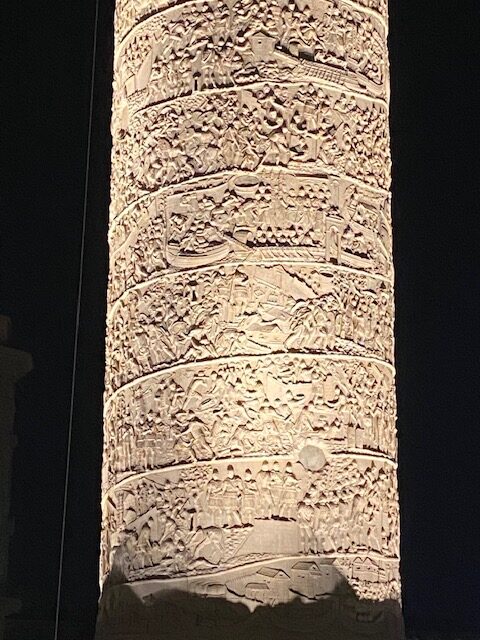
Sculptures of Ara pacis
The Ara Pacis Augustae is a massive altar dating back to the I century AD in honour of a new period of peace inaugurated by Augustus.
The Ara Pacis has stunning sculpture along its sides and has been restored to its previous glory, becoming one of the most interesting ancient monuments in Rome for history lovers.
Sculptures on Vittoriano
The Vittoriano is the large white building dominating Piazza Venezia and a treasure trove of sculptures.
Here, you have the main equestrian statue to Vittorio Emanele II but you also have many other depicting symbols of values and virtues and even a statue of Rome Goddess herself. You can read all about the Vittoriano and its symbols here.
Barcaccia Fountain by Bernini
Barcaccia is the name of one of the most famous fountains by Bernini in Rome. Located in Piazza Venezia, it represents a sinking ship and is a wonderful piece of sculpture as well as one of the most famous fountains in Rome.
You can read about it and about Piazza di Spagna here.
I hope you enjoyed this overview of the best statues in Rome and the best sculptures in Rome and it helped you pick the statues of Rome you most want to see in person. Safe travel planning!

